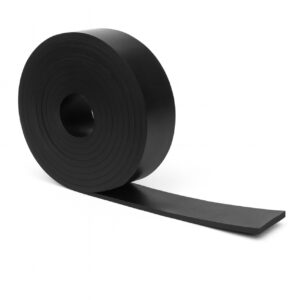Description
Neoprene Sponge Cord – Closed-Cell Sealing & Cushioning
Our neoprene sponge cord is a flexible, closed-cell rubber profile ideal for creating dust, air and water seals in doors, hatches, electrical enclosures, glazing systems and marine equipment.
✅ Durable & weather-resistant – withstands -40 °C to +90 °C for long-term sealing indoors or outdoors.
✅ Closed-cell construction – low water absorption for reliable environmental protection.
✅ Excellent compression recovery – compresses 20–30 % to fill gaps and maintain an effective seal.
✅ Easy to cut & join – create custom O-rings or continuous gaskets with simple adhesive bonding.
Choose from a wide range of diameters to suit grooves, channels or mating surfaces. Sold in convenient coils for fast installation or bulk manufacturing.
Technical Specifications
| Material | Closed-cell Neoprene (CR) Sponge |
|---|---|
| Density | 130–180 kg/m³ (typical) |
| Hardness | ~5–10 Shore 00 (soft sponge) |
| Temperature Range | -40 °C to +90 °C (short peaks higher) |
| Compression Deflection | 20–30 % recommended for effective seal |
| Water Absorption | Very low (closed-cell structure) |
| Chemical Resistance | Good resistance to oils, greases and ageing |
| UV / Ozone Resistance | Moderate (for prolonged UV exposure consider EPDM) |
| Colour | Black |
| Standard Supply | Coils (various diameters) – see size selector |
| Custom Options | Adhesive backing, cut lengths or vulcanised rings on request |
Neoprene Sponge Cord – FAQs
What is neoprene sponge cord used for?
Commonly used for sealing, gasketing and cushioning in doors, hatches, electrical enclosures, HVAC panels, street furniture and marine applications. It compresses to fill gaps and dampen vibration.
How do I choose the right diameter?
Measure your groove or gap and pick a cord slightly larger than the gap so it compresses 20–30% when installed. Example: 6 mm gap → 8 mm cord.
What is the temperature range?
Typical service range: -40°C to +90°C (short peaks higher). For sustained high-temperature or weather-exposed seals, consider EPDM.
Is it closed cell and water-resistant?
Yes — it’s a closed-cell neoprene sponge that resists water absorption and provides an effective environmental seal when correctly compressed.
Can I join the ends to make an O-ring?
Yes. Cut square, apply a suitable cyanoacrylate/rubber adhesive, butt the ends and hold until set. For critical seals, consider a factory-vulcanised ring.
Chemical/UV/weather resistance?
Good resistance to oils and ageing. For prolonged outdoor UV/ozone exposure, EPDM generally performs better; indoors or light outdoor use, neoprene is suitable.
What lengths are supplied?
Supplied in coils. Standard coils shown per size on this page (see size selector). Custom cut lengths available on request.
Shipping & returns
Orders placed by 2pm (UK) ship same working day when in stock. Standard delivery 1–3 working days. 30-day returns on stock items (unused, in original condition). See Delivery & Returns.




